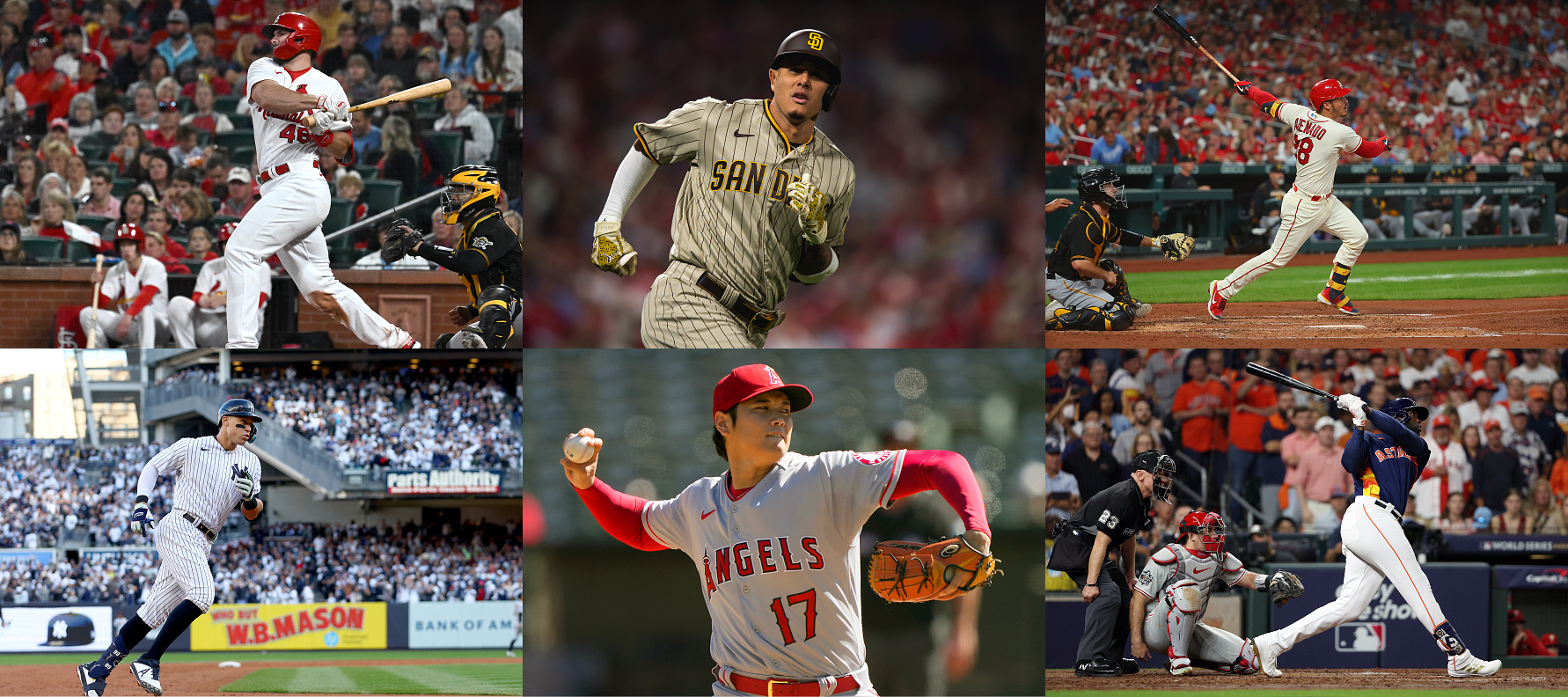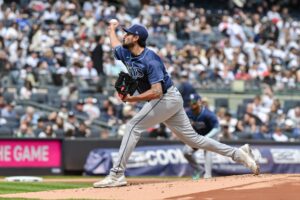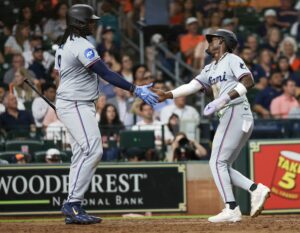Who the 2022 AL MVP and NL MVP Should Be: The Numbers
MLB Network announced the awards finalists — the top three vote-getters in each league’s award category — Monday night, November 7. As happens every year, the finalists generated lots of discussion. A big point of contention, as usual, came over the definition of “valuable,” with many saying that a player can’t be valuable if he doesn’t get his team to the postseason.
But baseball is a team sport. More specifically, it’s a team sport where, on offense, everyone has to have a turn. On defense, everyone on the field must do their part when a ball is put in play. Baseball is not like football, basketball, or soccer, where teams constantly get the ball to their elite players in crunch time. Those sports often see certain players not get the ball in those situations as well. On the 1988 Oakland Athletics, AL MVP Jose Canseco (.307/.391/.569, 187-for-610, 34 doubles, 42 homers, 124 RBI, 120 runs scored) could only bat once every nine times. And Mike Gallego (.209/.298/.260, 58-for-277, eight doubles, two homers, 20 RBI, 38 runs scored) had to bat once every nine times. Furthermore, the order in which they bat is set before the game, cannot change during the game, and does not reset at the beginning of an inning.
Starting pitchers take part in every defensive play — even if the role is “threw the pitch that got hit” — but they pitch once every five days. Relievers can pitch in more games, but they’re typically in for an inning or two at a time.
What the Most Valuable Player Truly Is
The Most Valuable Player award is not a Cy Young Award for hitters — that’s the Hank Aaron Award. It’s not an award for “who did the most to win games for his team,” because everyone on the team has to play a role in winning. In the first sentence of the instructions to voters on the MVP ballot, it says “actual value of a player to his team, that is, strength of offense and defense.” At the end of the first paragraph of the instructions, it specifically says, “The MVP need not come rom a division winner or other playoff qualifier.” The last sentence of the instructions says, “Keep in mind that all players are eligible for MVP, including pitchers and designated hitters.”
Remember also that the MVP ballots are submitted electronically by midnight of the last day of the regular season. Therefore, by default, it is a regular-season award. In other words, the postseason does not at all matter to this award.
The meaning of “valuable” has been debated for many years. Here is one that factors in everything described up to this point — the “once every nine times, once every five days” concept, everyone needing to contribute, it being so difficult to hide liabilities. Which player increased his team’s chances to win the most? For decades, it was hard to quantify “value.” However, there is a stat many aren’t aware of that does quantify on-field value in an objective way — Win Probability Added (WPA). We’ll try to explain it as briefly as possible.
WPA, LI, and Situational Wins
The basis of WPA is straightforward. Every single base-out situation (which bases are occupied, how many outs there are — 24 possible combinations), along with its half-inning and the score difference, has a win probability (or Win Expectancy) attached to it. We have detailed records of the hundreds of thousands of baseball games in the history of Major League Baseball, so we know what percentage of the time that the offensive and defensive teams go on to win the game. That is Win Probability (WP or WE, for Win Expectancy).
The difference between the WP before the at-bat and after the at-bat is the WPA. For example, say it is the bottom of the first of a scoreless game. When the leadoff hitter comes to bat, his team’s WP is 55%. If he singles, the WP becomes 58%, so his WPA for that play is + .030. The pitcher’s WPA for that play, conversely, is –.030.
Short-term vs. Long-term
Keeping track of WPA can quickly show who was the most valuable player in a game. It also works well for an entire series or an entire postseason. However, going much longer than that brings up a problem. To illustrate, let’s look at Kirk Gibson’s famous walk-off home run in Game One of the 1988 World Series. Before the 3–2 slider from Dennis Eckersley, the A’s had an 87% WP. The situation was runner on second, two out, visiting team ahead by one. If Gibson made an out, the A’s WP would have become 100%, giving Gibson –.130 WPA. Instead, Gibson homered, changing the A’s WP to 0% and the Dodgers’ WP to 100%. That gave Gibson +.870 WPA. Because that one at-bat had such a wide potential swing in WP, that is a “high-leverage” situation. The leverage of a situation is measured by Leverage Index (LI).
Long-term, if a certain player continually comes to the plate as a late-game pinch-hitter with the game on the line, his WPA has the potential to be a giant see-saw. If he hits so much as two home runs in that situation, his WPA will skyrocket. To correct for this, we have a stat called Situational Wins. This takes a player’s WPA and divides it by LI.
Situational Wins Leaders and the 2022 MVP Award
Here is the National League leaderboard for Situational Wins. Position players and pitchers are mixed together. The Situational Win number listed for position players is for batting, and for pitchers, it is for their pitching.
| Rank | Name | Team | Pos | Sit Wins |
| 1 | Paul Goldschmidt | STL | 1B | 6.0 |
| 2 | Sandy Alcantara | MIA | SP | 4.4 |
| 3 | Manny Machado | SDP | 3B | 4.2 |
| 4 | Max Fried | ATL | SP | 4.0 |
| 5 | Freddie Freeman | LAD | 1B | 3.9 |
| 6 | Zac Gallen | ARI | SP | 3.8 |
| 7 | Mookie Betts | LAD | RF | 3.6 |
| 8 | Tony Gonsolin | LAD | SP | 3.6 |
| 9 | Austin Riley | ATL | 3B | 3.5 |
| 10 | Clayton Kershaw | LAD | SP | 3.4 |
This brings up a valid argument — if a team has four players in the top ten, and their situational wins are all close, then was any one more valuable than the others? For those who think no more than, say, two players from one team should be in the top ten, here are the next five players whose teams don’t have two in the top ten: Juan Soto (WSN/SDP, 3.3), Aaron Nola (PHI, 3.2), Max Scherzer and Pete Alonso (NYM, 3.1 for both), and Merrill Kelly (ARI, 3.0). (Note: Spencer Strider had 3.2, but the Braves already have two players in the top ten.)
American League Leaderboard
Here is the American League leaderboard for Situational Wins. Like the National League, the Situational Win number listed for position players is for batting, and for pitchers, it is for their pitching. Since Shohei Ohtani is a two-way player, his number is the sum of his batting and pitching situational wins — 3.5 for batting, 3.3 for pitching.
| Rank | Name | Team | Pos | Sit Wins |
| 1 | Aaron Judge | NYY | RF | 8.6 |
| 2 | Shohei Ohtani | LAA | SP/OF | 6.8 |
| 3 | Yordan Alvarez | HOU | DH/LF | 5.8 |
| 4 | Mike Trout | LAA | CF | 5.1 |
| 5 | Justin Verlander | HOU | SP | 4.8 |
| 6 | Nestor Cortes | NYY | SP | 3.8 |
| 7 | Jose Altuve | HOU | 2B | 3.5 |
| 8 | Alek Manoah | TOR | SP | 3.3 |
| 9 (T) | Dylan Cease | CHW | SP | 3.2 |
| 9 (T) | Jose Ramirez | CLE | 3B | 3.2 |
| 9 (T) | Rafael Devers | BOS | 3B | 3.2 |
| 9 (T) | Shane Bieber | CLE | SP | 3.2 |
2022 MVP Award Finalists and Who Should Win
From these lists, Paul Goldschmidt should be the 2022 NL MVP, and it’s not close. The other two finalists should be Sandy Alcantara and Manny Machado. Alcantara, who has a good chance of winning the Cy Young, was not a finalist, but the other two were, along with Nolan Arenado. According to Situational Wins, Arenado — not by a longshot — should not have been a finalist, given that he is tied for 24th with Mets center fielder Brandon Nimmo and Dodgers setup man Evan Phillips.
The 2022 AL MVP should be Aaron Judge, also by a comfortable margin. Shohei Ohtani and Yordan Alvarez should be second and third, respectively. Those three are the American League finalists, so the voting — at least so far — lines up with the numbers. Ninth and tenth place bring up an interesting conundrum, given that there is a four-way tie for ninth. That is where the voters and their discernment come into play.
What constitutes “most valuable” will always be debated. However, having an objective stat that can quantify who increased his team’s chances of winning the most can certainly be a game-changer. Some advanced stats solely give information that is in the category of “Oh, That’s Interesting.” Others actually serve a useful purpose by answering pertinent questions that more traditional statistics can’t. Win Probability (Win Expectancy), WPA, Leverage Index, and Situational Wins are certainly useful. For this season, they are especially useful in sorting out who truly deserves to be the 2022 MVP for their respective leagues — Paul Goldschmidt and Aaron Judge.
MLB Network will announce the 2022 MVP winners starting at 6 pm Eastern on Thursday, November 17.
See also:
The 2021 MVP Finalists Truly Were the Most Valuable. Here’s Objective Proof.
Main Photo:
The main photo is a composite of the following images:
Image One:
Embed from Getty Images
Image Two:
Embed from Getty Images
Image Three:
Embed from Getty Images
Image Four:
Embed from Getty Images
Image Five:
Embed from Getty Images
Image Six:
Embed from Getty Images
Players Mentioned:
Jose Canseco, Mike Gallego, Kirk Gibson, Dennis Eckersley, Paul Goldschmidt, Sandy Alcantara, Manny Machado, Max Fried, Freddie Freeman, Zac Gallen, Mookie Betts, Tony Gonsolin, Austin Riley, Clayton Kershaw, Juan Soto, Aaron Nola, Max Scherzer, Pete Alonso, Merrill Kelly, Spencer Strider, Shohei Ohtani, Aaron Judge, Yordan Alvarez, Mike Trout, Justin Verlander, Nestor Cortes, Jose Altuve, Alek Manoah, Dylan Cease, Jose Ramirez, Rafael Devers, Shane Bieber, Nolan Arenado, Brandon Nimmo, Evan Phillips






